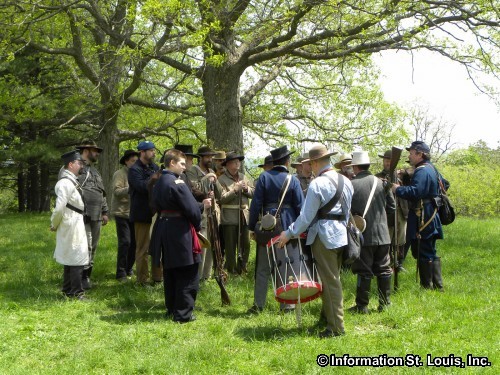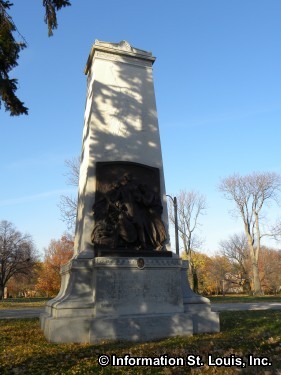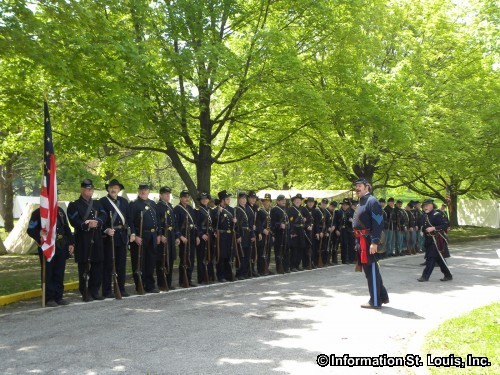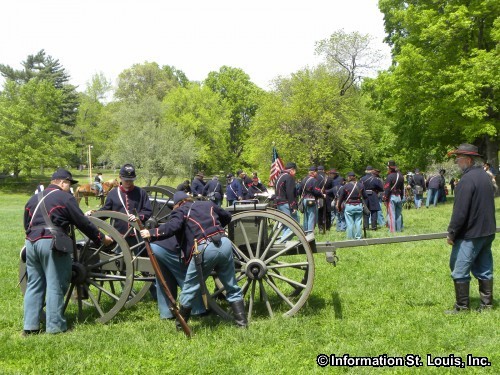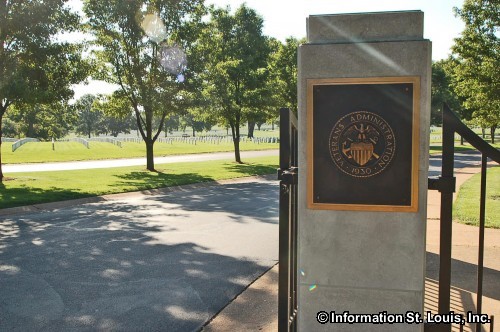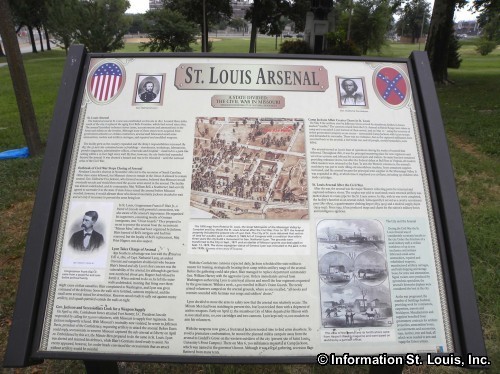The Civil War in St Louis
It could be stated that the beginning of the Civil War started in the "Slave" State of Missouri even before the firing on Fort Sumter in 1861, with the bloody Kansas-Missouri "Border Wars". The repeal of the Missouri Compromise in 1854 caused a rush of anti-slavery and pro-slavery factions into Kansas to influence whether Kansas would be admitted into the Union as a "Free" or "Slave" state. Years of terror, where atrocities were committed against pro-Southern citizens by Federal troops and then in retaliation, against anti-slavery citizens by pro-Southern guerrilla militia, continued until the beginning of the Civil War.
The Camp Jackson Affair
The Civil War officially came to the State of Missouri with an event known as the "Camp Jackson Affair". "Camp Jackson" was a bivouac area, laid out in what was known as Lindell Grove, for the encampment of the Missouri Volunteer Militia. The Militia had gathered for a yearly event of muster and drill exercises in May of 1861. It was given the nickname "Camp Jackson" for the Missouri governor, Claiborne F. Jackson, who was a southern sympathizer. Missouri's lawmakers had declared earlier that Missouri, a slave state, would remain neutral in regards to the Civil War, but remaining so would prove hard to do. The residents of the City of St. Louis were mostly pro-Union, being made up of a large number of anti-slavery German immigrants. But the residents from the outlying Missouri countryside were pro-South, having emigrated to Missouri from Kentucky and Tennessee. The Camp Jackson Affair would cause the balance in Missouri to be tipped in favor of the South.

The U.S. Arsenal was located in St. Louis and there was concern that Governor Jackson was going to attack and take control of the Arsenal for the Confederacy. Captain Nathaniel Lyon was put in charge of defending the Arsenal for the Federal Government. He learned that Governor Jackson had been in contact with the Confederate President, Jefferson Davis, to request arms to use in capturing the Arsenal. Those arms were delivered to Camp Jackson and to General Daniel M. Frost, commanding officer of the Missouri Volunteer Militia. Captain Lyon, deciding that an attack was eminent, ordered his volunteer regiments to march on Camp Jackson and surround the encampment. Greatly outnumbered, the Militia "surrendered" and were marched through the streets of St. Louis to the Arsenal. Citizens of the city had gathered to watch and someone shot into the troops. The Federal troops began shooting back and in the end 28 people, including women and children, were killed and others wounded. In spite of the Camp Jackson Affair, the actions by Captain Lyon, who was later promoted to General, went a long way in securing the City of St. Louis, and the state of Missouri, for the Union.
Camp Jackson, the Arsenal and Lyon Park
The location of Camp Jackson was on what is now the campus of St. Louis University, east of Grand Avenue, and is today called the Frost Campus in honor of General Daniel Frost. The "Arsenal" is still located in the city of St. Louis at Second and Arsenal Streets and is an active military base, although no longer a U.S. Arsenal. Across the street from the Arsenal is Lyon Park, a St. Louis city park, which is on land that was donated to the city of St. Louis by the Federal government with stipulations that it would always be a park honoring General Nathaniel Lyons.
Alton Illinois and the Civil War
 In 1860 the First Illinois Prison in Alton, built in 1833, was closed by the State of Illinois. The Federal Government reopened it as the Alton Federal Military Prison in 1862 to house Confederate prisoners because the two St. Louis prisons were full. Over 11,000 prisoners would eventually be confined in the prison by the end of the Civil War. The conditions in the prison were very bad and many prisoners would die from infectious diseases while imprisoned there. The Confederate prisoners who died at the prison were buried at the North Alton Confederate Cemetery in Alton.
In 1860 the First Illinois Prison in Alton, built in 1833, was closed by the State of Illinois. The Federal Government reopened it as the Alton Federal Military Prison in 1862 to house Confederate prisoners because the two St. Louis prisons were full. Over 11,000 prisoners would eventually be confined in the prison by the end of the Civil War. The conditions in the prison were very bad and many prisoners would die from infectious diseases while imprisoned there. The Confederate prisoners who died at the prison were buried at the North Alton Confederate Cemetery in Alton.
Smallpox Epidemic
In August of 1863 a smallpox epidemic began to spread through the prison. Those prisoners who contracted smallpox were quarantined by being sent to a hospital built for this purpose on an island in the middle of the Mississippi River which was later nicknamed "Smallpox Island". Almost 250 prisoners died and were buried on Smallpox Island. After the war, the island was abandoned and as the river flooded and changed course throughout the years, the hospital, graves and the island were eventually lost. Today, located in the Lincoln Shields Recreation Area in West Alton Missouri, there stands a memorial to the Confederate soldiers who died and where buried on Smallpox Island. A small remnant of the ruins of the Alton Federal Prison can be seen on Williams Street in Alton.
Ironclads and Carondelet
James Buchanan Eads was commissioned by the Federal government in 1861 to build a new type of river boat that were called Ironclads. These iron plated boats would provide defense of the Mississippi River against the Confederate Navy during the Civil War. Most of these ironclads were built at Eads' converted Carondelet Marine Railway Company located on banks of the Mississippi River, just south of St. Louis in Carondelet Missouri. Along with ironclads, Eads also built river monitors and ironclad mortar boats at his Carondelet shipyard. All of these vessels were used very successfully to defend the Mississippi River during the Civil War.
New Madrid Missouri
Eads ironclads were used in the battle for control of New Madrid Missouri which was a strategic point on the Mississippi River during the Civil War. The expelled Missouri Governor, Claiborne E. Jackson, a Southern sympathizer, came to New Madrid after the Camp Jackson Affair. While in New Madrid he signed a secession proclamation for the State of Missouri. Two Confederate forts, Fort Thompson and Fort Bankhead, and Island No. 10 made New Madrid a Confederate stronghold and a strategic point for control of the upper Mississippi River Valley. It took 20,000 Union troops and four 128-pound siege guns to break the Confederate stronghold and gain control of New Madrid and the entire length of the Mississippi River along Missouri and northward.
Cemeteries and the Civil War
Several cemeteries around the Metro area were used to inter Union and Confederate soldiers. Jefferson Barracks National Cemetery, originally built in 1826 as the first permanent U.S. Army base west of the Mississippi, has both Union and Confederate soldiers interred there, as well as soldiers from all wars the U.S. has been involved in. In Alton Illinois, the Alton National Cemetery holds the remains of 212 Union soldiers who died while recovering in the hospital and the North Alton Confederate Cemetery was established for those Confederate soldiers who died while in the Alton Federal Prison. There are 1,354 names inscribed on the Monument to the Confederates who are interred in the North Alton Confederate Cemetery.
Missouri Civil War Museum

To commemorate the part that Missouri played in the Civil War, the Missouri Civil War Museum opened in 2013 at Jefferson Barracks. The museum is housed in the restored Post Exchange and Gymnasium Building that was built in 1905 for use by the commissioned officers stationed at the base as an athletic and activity center. The museum is the fourth largest Civil War museum in the United States and serves as a museum, library, and educational center.
Civil War in St Louis Photo Gallery

Alton National Cemetery, Union Soldiers graves Link

Jefferson Barracks National Cemetery Link

Missouri Civil War Museum at Jefferson Barracks Link

Confederate Memorial at the Lincoln Shields Recreation Area Link

Ruins of the Alton Military Prison which housed Confederate Soldiers Link
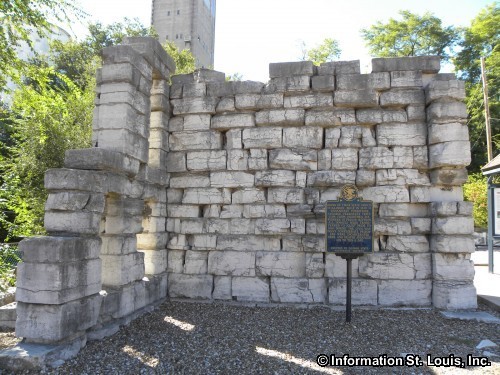
Ruins of the Military Prison used for Confederate Soldiers Link

Confederate Monument in the Confederate Cemetery, Alton Illinois Link
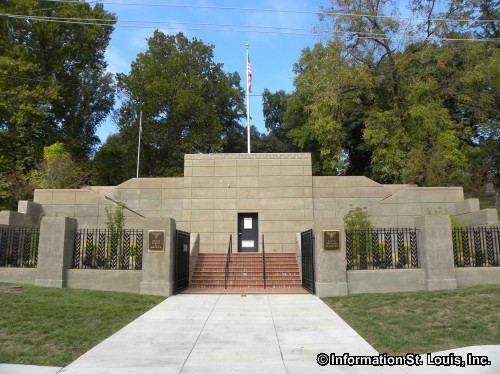
Alton National Cemetery rostrum built by the WPA in 1938 Link
Hey There! Do You Know What Your Home Is Worth Today?
Check Here Now!Events in St Louis History
Have You Considered A Career In Real Estate?
Learn MORE Here!St Louis Missouri Real Estate For Sale
New Construction For Sale: 1320
Condos For Sale: 697
Commercial For Sale: 1799
Acreage For Sale: 1263
Multi-Family 5+ For Sale: 103
Multi-Family 2-4 For Sale: 444
Lots For Sale: 3089
Total Properties For Sale: 18240


